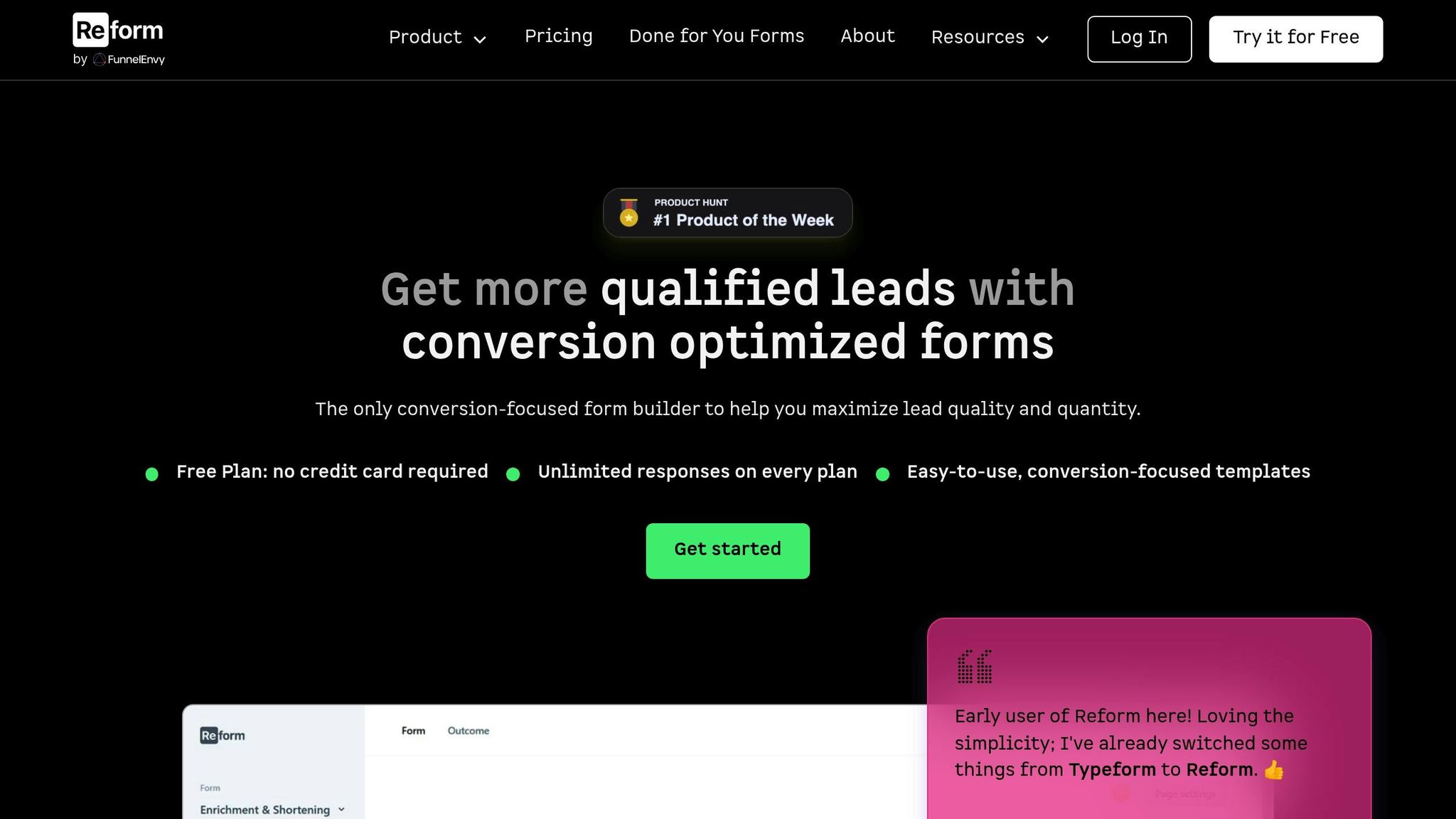How Marketing Automation Enhances CRM Scalability

When your business grows, managing customer relationships gets harder. Marketing automation solves this by integrating with your CRM to handle repetitive tasks, improve lead management, and deliver personalized experiences at scale. Here’s how it helps:
- Lead Nurturing: Automates follow-ups and delivers tailored messages based on user behavior, ensuring no lead is overlooked.
- Segmentation: Dynamically groups customers by behavior or demographics, enabling targeted communication without manual effort.
- Task Automation: Handles data entry, lead routing, and follow-ups, saving time and reducing errors.
Tools like Reform improve CRM workflows by collecting detailed, organized data through smart, customizable forms. This ensures your CRM operates efficiently even as your customer base grows.
Understanding CRM Scalability and Common Problems
What is CRM Scalability?
CRM scalability is all about how well your system can grow alongside your business without falling apart or needing a complete rebuild. Think of it like comparing a single-location restaurant to a nationwide chain. Both aim to serve customers, but only the chain has built-in processes to expand smoothly without constant restructuring.
A scalable CRM can handle a growing number of leads, customers, and data without compromising performance or user experience. For instance, if your contact list jumps from 500 to 50,000, the system should still deliver quick search results, seamless data entry, and accurate reporting. The goal? To stay efficient and effective, no matter how much your business grows.
This also means your CRM should adapt to more complex sales processes, accommodate additional team members, and integrate with new tools - all without slowing down or adding extra manual tasks. Scalability isn’t just about storing more data; it’s about processing and analyzing that data effectively to strengthen customer relationships and improve business outcomes.
Next, let’s dive into the challenges that can derail CRM scalability.
Common Scalability Problems
As businesses grow, they often hit the same stumbling blocks when their CRM systems can’t keep up. These issues tend to snowball, leading to major productivity losses and a noticeable drop in customer satisfaction.
One big issue is data silos. As companies expand, different departments often rely on separate systems that don’t communicate. Marketing might manage leads in one tool, while sales uses another, leaving gaps where leads slip through. Meanwhile, customer service teams struggle to access complete histories, forcing clients to repeat themselves - a frustrating experience for everyone.
Another challenge is manual processes and system performance issues. What works for 100 leads becomes unmanageable with 1,000. As databases grow, unoptimized systems slow down. Searches that used to take seconds now take minutes, and reports that once loaded instantly start timing out. Team members, tired of waiting on sluggish systems, resort to creating their own spreadsheets. This not only wastes time but also worsens the data silo problem.
Finally, inconsistent customer experiences can arise. Without unified customer data or automated workflows, some leads get immediate attention while others are left waiting for weeks. These inconsistencies can harm relationships and erode trust.
Over time, these problems feed into each other, creating a vicious cycle where growth actually drags down business performance. Teams grow frustrated with inefficient systems, and customers notice the decline in service quality. The way forward? Invest in automation and integration tools that can handle increased complexity without adding extra manual work.
Integrating CRM and Marketing Automation | Office Hours With Mike Cooch
How Marketing Automation Improves CRM Scalability
When it comes to scaling your CRM, marketing automation is a game changer. It creates smart workflows that handle routine tasks, freeing your team from manual processes. This means your CRM isn't just a data storage tool - it becomes a powerful system that actively drives better results as it grows. Automated workflows make lead management, segmentation, and task handling more efficient, laying a solid foundation for growth.
Streamlining Lead Nurturing
As your contact list grows, managing leads manually becomes overwhelming. Your team either struggles to keep up, risking burnout, or sacrifices quality with delayed and impersonal follow-ups. That’s where automation steps in.
Automated lead nurturing sequences work behind the scenes, delivering the right content at the right time based on a lead’s behavior. For instance, if someone downloads a pricing guide, they’ll receive follow-up emails tailored to that action - different from the emails sent after a product demo.
Behavioral triggers add another layer of efficiency. If a lead visits your pricing page multiple times in a week, the system can notify your sales team or send targeted content automatically. Imagine trying to do that manually for hundreds - or thousands - of leads. Automation makes it possible and ensures no one slips through the cracks.
Advanced segmentation further enhances this process. Leads are grouped by factors like industry, company size, engagement level, or their stage in the buying journey. This allows your CRM to deliver personalized messages to each group without requiring constant oversight from your team. The result? A scalable system that grows with your business.
Better Segmentation and Targeting
Relying on manual segmentation is fine when you’re dealing with a small database, but it quickly falls apart as your customer base expands. Sorting thousands of contacts into meaningful groups becomes nearly impossible without automation.
Dynamic segmentation solves this by automatically updating customer groups in real time. For example, a prospect who makes their first purchase is instantly moved to an “active users” segment. If their engagement drops, they might shift to an “at-risk” group, prompting targeted outreach.
Take it a step further with predictive segmentation. By analyzing historical data, the system can identify patterns, like customers who are likely to churn or leads most likely to convert. This helps your team focus their efforts on the activities that will have the biggest impact. For instance, customers who reorder every 90 days can automatically receive reminder emails a few days before their typical purchase cycle ends, while high-value clients might receive personalized offers or VIP messaging.
This dynamic and predictive approach ensures your CRM remains effective and scalable, no matter how large your database grows.
Automating Repetitive Tasks
As your CRM grows, so does the volume of repetitive tasks - things like data entry, lead assignments, and follow-up scheduling. These tasks can eat up valuable time, but automation eliminates the bottleneck.
For example, automation can instantly route leads to the right team member based on factors like location, expertise, or workload. This speeds up response times and ensures your team works more efficiently.
Data enrichment is another time-saver. When a lead enters your system with just an email address, automation tools can fill in the gaps by adding details like their company name, social media profiles, and other key information. This gives your team the context they need to have meaningful conversations from the start.
Follow-up automation ensures no lead is left behind. The system can schedule check-ins, send reminder emails, and update deal statuses based on customer actions. If a prospect doesn’t respond to an email, the system keeps nurturing them with relevant content until they’re ready to engage.
Automation also simplifies transitions. When a lead becomes a customer, the system can automatically create onboarding tasks, notify the appropriate teams, and kick off a welcome sequence. This ensures a smooth handoff and consistent customer experiences.
sbb-itb-5f36581
Using Reform to Build Scalable Marketing and CRM Workflows

If you want to scale your CRM with automation, capturing high-quality data is non-negotiable. That’s where Reform steps in.
Reform strengthens CRM scalability by ensuring the data you collect is not just abundant but actionable. While automation handles the backend processes, the quality of input data determines how effective your CRM will be. Reform, a no-code form builder, bridges the gap between lead capture and CRM growth. It upgrades basic forms into advanced lead capture tools that deliver rich, detailed data directly into your CRM.
These intelligent forms streamline the process, routing critical prospect details into your CRM. This fuels automated workflows, reduces integration headaches, and allows your business to grow without missing a beat.
Key Features of Reform for CRM Integration
Reform’s multi-step forms turn the traditional lead capture process into an engaging experience. Instead of overwhelming prospects with lengthy forms, you can break them into smaller steps, making it easier for users to provide information. This approach not only improves completion rates but also gathers the segmentation data your CRM needs to power automation.
With conditional routing, Reform makes forms smarter. Depending on a prospect’s answers, the form adapts its questions and directs leads to the right CRM pipelines, ensuring a personalized and efficient process.
Reform also enriches your data automatically. For example, if a prospect submits only their email, Reform can pull in additional details like company information and social profiles.
Real-time analytics provide instant insights into how your forms are performing. You can pinpoint where prospects drop off, identify questions that may be causing hesitation, and compare the performance of different form variations. This data is invaluable for keeping your lead generation efforts on track.
Reform integrates directly with platforms like HubSpot and Close.io, and it supports webhooks and APIs for seamless data flow. Features like duplicate detection and custom field mapping ensure your CRM receives clean, organized data that’s ready to drive automation.
Benefits of No-Code Customization
Reform’s no-code customization tools let your team adjust forms quickly and easily as your business needs change. This flexibility is a game-changer as you scale. Marketing teams can create and tweak forms without waiting on developers, enabling rapid testing and iteration. Whether you’re launching a new campaign, updating lead qualification criteria, or tailoring forms for specific audiences, changes can be made in minutes instead of weeks.
Customization also extends to branding and design. Reform allows you to design forms that align perfectly with your brand, ensuring a consistent experience from the first interaction to CRM entry. For advanced needs, you can use custom CSS and JavaScript to add functionality while keeping your branding intact.
A/B testing is another standout feature, helping you fine-tune conversion rates by experimenting with form layouts, question sequences, and conditional logic. As your lead volume grows, these insights become essential for keeping acquisition costs under control.
Reform even includes abandoned submission tracking, which helps you recover leads who started but didn’t finish filling out a form. As your lead volume increases, this feature becomes more valuable - every recovered lead represents a potential opportunity that might have been lost.
With Reform, your lead capture process grows alongside your business, adapting to new markets, products, and more advanced lead scoring systems - all without requiring major overhauls.
Conclusion: Improving CRM Scalability with Marketing Automation
Marketing automation transforms CRM scalability from a hurdle into an opportunity for growth. By automating repetitive tasks, businesses can save valuable time for strategic initiatives while ensuring consistency, even as customer numbers grow.
This efficiency leads to three key CRM advancements: scalable lead nurturing, where automated workflows deliver personalized experiences to thousands of prospects at once, resulting in better-qualified leads and higher conversion rates; advanced segmentation, which automatically organizes customers by behavior and demographics, enabling tailored campaigns at scale; and process automation, which handles tasks like lead scoring and follow-up emails, ensuring no opportunity slips through the cracks.
The real strength of this approach lies in automation’s ability to adapt workflows to evolving demands without compromising efficiency, even during periods of rapid growth. It allows your CRM to grow seamlessly alongside your business.
Reform plays a vital role in maximizing these benefits by ensuring your CRM receives clean, high-quality data. With features like multi-step forms, conditional routing, and lead enrichment, Reform creates a solid foundation for automation. When your CRM is powered by organized, reliable data from Reform’s intelligent forms, automated workflows can operate at their full potential.
FAQs
How can marketing automation help a growing business scale its CRM effectively?
Marketing automation empowers growing businesses to scale their CRM by simplifying essential tasks like lead nurturing, customer segmentation, and workflow automation. These tools help businesses handle a larger customer base while still delivering personalized communication, ensuring steady engagement without stretching resources too thin.
By taking over repetitive tasks - think email follow-ups or data entry - marketing teams can shift their focus to more strategic efforts. Plus, with advanced segmentation, businesses can deliver the right message to the right audience at the perfect moment, boosting both conversion rates and customer satisfaction. This streamlined approach enables growth while keeping quality and efficiency intact.
What routine tasks can be automated to make your CRM more efficient?
Automating repetitive tasks can free up valuable time and reduce the need for manual work, making your CRM more effective. Here are some common ways automation can simplify your workflow:
- Scheduling follow-ups: Set up automatic reminders or send follow-up emails based on specific timelines you define.
- Sending email campaigns: Trigger personalized emails tailored to customer actions or lead status, ensuring timely and relevant communication.
- Updating contact records: Keep customer details up-to-date automatically when new information is added or collected.
- Lead data entry: Capture and organize lead information directly into your CRM, skipping the need for manual data input.
By handling these routine tasks automatically, you can dedicate more energy to building meaningful customer connections while keeping your CRM organized and ready for growth.
How do Reform's multi-step forms and conditional routing enhance CRM data quality?
Reform's multi-step forms make collecting data easier by splitting long forms into smaller, bite-sized sections. This approach not only helps users avoid mistakes but also encourages them to complete the form, resulting in more accurate and thorough submissions. The result? Better-quality data feeding into your CRM.
With conditional routing, forms become smarter by tailoring questions based on earlier answers. This means users only see questions relevant to them, cutting out irrelevant information and streamlining the data collection process. It’s a win-win for both users and your CRM system.
Related posts
Get new content delivered straight to your inbox

The Response
Updates on the Reform platform, insights on optimizing conversion rates, and tips to craft forms that convert.
Drive real results with form optimizations
Tested across hundreds of experiments, our strategies deliver a 215% lift in qualified leads for B2B and SaaS companies.





